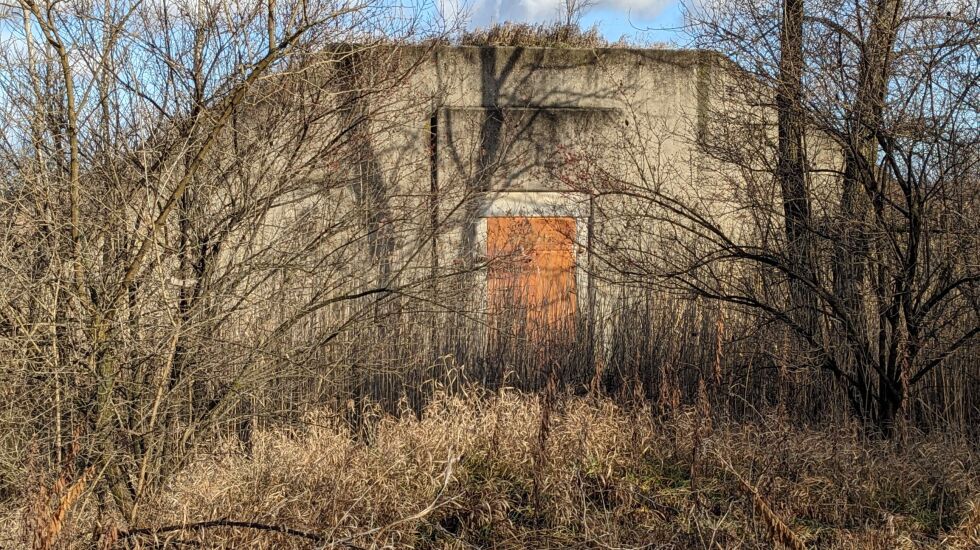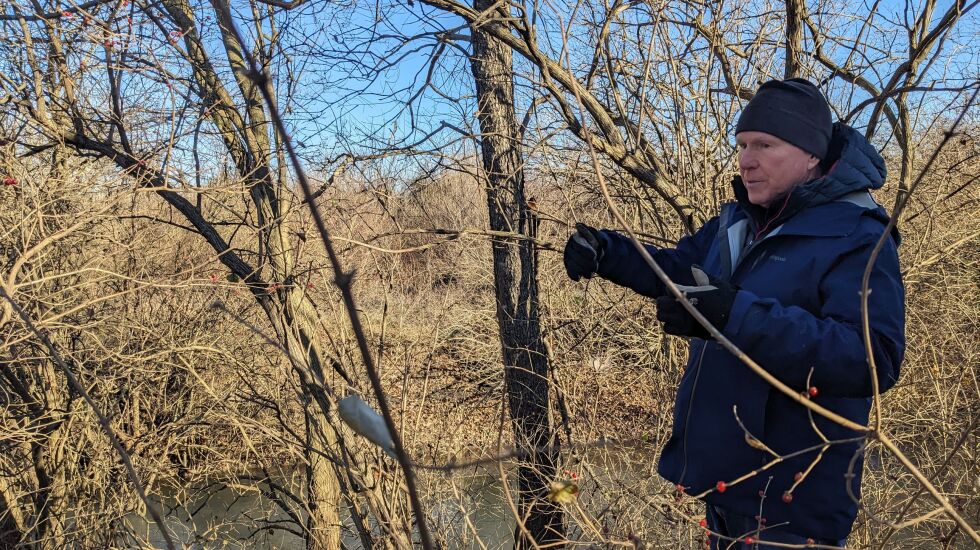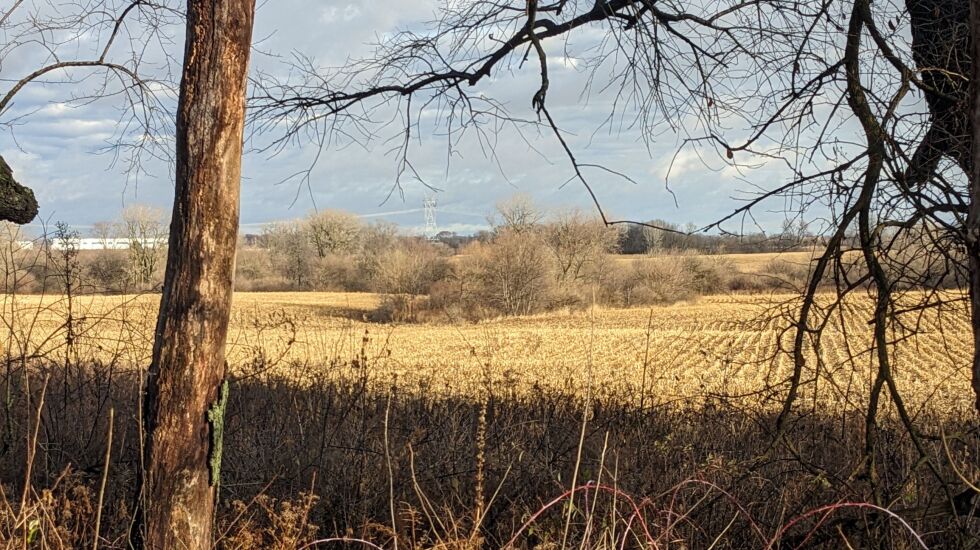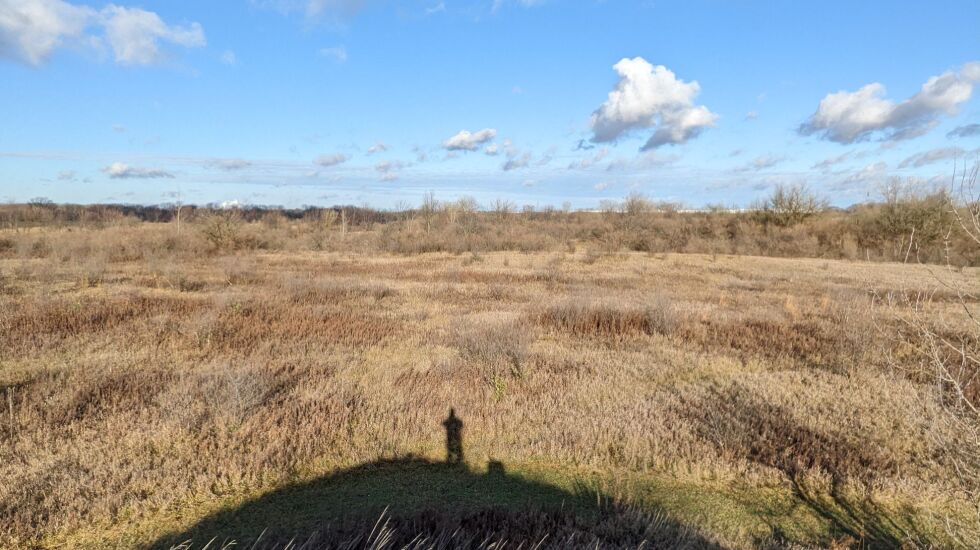
A shiny, jointed green plant, think skinny miniature bamboo, grew thickly at the upper end of several feeder fingers of Grant Creek at Midewin National Tallgrass Prairie.
“Scouring rush,” Gary Sullivan explained. “It was used to clean pots and pans.”
The evergreen stems of Illinois’ largest horsetail feel gritty.
Illinoiswildflowers.info gives this history, “These tough stems were used to scour pots, pans, and floors during pioneer days, hence the common name. In spite of this common name, the Scouring Rush (Equisetum hyemale affine) is not a rush, but a horsetail. The horsetails are closely related to ferns and both were common during the Carboniferous period (280-345 million years ago), when tree-sized horsetails and ferns occurred. The coal deposits of Illinois were formed in large part from the ancestral plants of today’s horsetails and ferns.
Digging into history comes easily at Midewin, largest wild space in the Chicago area.
As the U.S. Forest Service describes in its site introduction, “Turning back the clock from a landscape dominated by rusting munitions factories and abandoned ammunitions bunkers into a 20,283 acre pristine tallgrass prairie makes the Midewin a compelling vision for landscape scale restoration.”
In late November, another step came in that vision.
Openlands and partner The Wetlands Initiative received a $1.5 million grant from the National Fish and Wildlife Foundation through the America the Beautiful Challenge to restore and expand 1,321 acres of grassland habitat across Midewin.
“It speaks to the potential of Midewin,” said Michael Davidson, new CEO of Openlands.
The project, in the Grant Creek watershed, will be from March, 2024, to July, 2025.
”This is the first America the Beautiful grant solely in Illinois,” said Paul Botts, president and executive director of TWI.
The project area is next to the existing 1,200-acre bison pasture. If familiar with the site, it’s north and northeast of the Iron Bridge Trailhead. An underlying premise of the grant is to open more public access and recreational use.
“I think of Midewin as a regional asset,” Davidson said. “I can’t think of a better way to get Chicagoans outdoors. This is an opportunity to appreciate the subtle magic of a classic Midwestern landscape. This is your backyard as a true regional assessment.”
Openlands, TWI and the U.S. Forest Service at Midewin will partner on the project.
“We’ll be hands on working with the tree-removal contractors,” Botts said. “Very hands on, not the beauty stuff, the nitty gritty.”

Last week, I rode around as Sullivan, TWI’s senior ecologist, and TWI’s Midewin project manager Jason Pettit assessed the grant area, what their staff could do and what would be the work of outside contractors.
“Right now, we have to get this opened up and see what we have,” Sullivan said.
Scouring rush was interesting to me, but not among major concerns. Bigger challenges will be with reed-canary grass, phragmites, Osage orange, invasive honeysuckle and autumn olive.
Much of the area is in agricultural fields, but most work will be on fencerows and along Grant Creek and its feeders.

As we drove around, Sullivan spotted a beaver dam on Grant Creek. In that spot, it’s a good thing.
“That’s the best beaver dam I’ve seen at Midewin.” Pettit said.
Logistical questions on when work may be done and what plants and trees should be kept will be done with Forest Service staff.
Sullivan thinks some cottonwoods, oaks, a cherry tree we saw, and some willows, especially some black willows, will be saved and utilized in the restoration.
Much woody removal needs to be done around bunkers in the bunker field east of Iron Bridge Trailhead. Removal of most bunkers will be a major future project, it’s not part of this one.

In early December, I met with Davidson and Emily Reusswig, Openlands vice-president of conservation and policy.
“This is our national park,” Reusswig said. “We think this is the next moment in Midewin.”
The project will include six restoration apprentices each year.
“These could be future managers and many want to be entrepreneurs,” Davidson said.
They envision it as the first part of large-scale restoration, including a remeandering, of the Grant Creek watershed.
Sullivan envisions a future where this landscape will be a “mosaic from mesic prairie to wet prairie.”
Reusswig aptly described the value of Midewin.
“It helps me move slower,” she said. “Go to the mountains and everybody is hiking fast. One square inch of Midewin is really magical. I hope it helps us slow down. We are a fast moving region.”
General informaton on Midewin is at fs.usda.gov/midewin.








